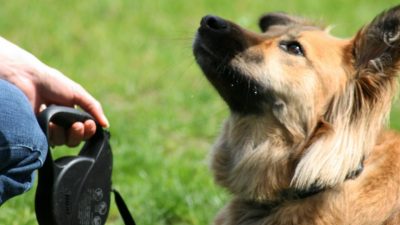Dogs are often described as man’s best friend – they are truly amazing and loyal companions. They come in different breeds, sizes, activity levels and diet requirements. It’s important to understand your dog’s needs and provide them with the appropriate training. Especially if it’s a new pup at home.
Today we’re collaborating with Kuan, an experienced dog trainer, to discuss the topic “dog training”:

Training Your Dog Begins on Day 1
Before anyone brings a dog home, it’s absolutely crucial to have a discussion with everyone in your household – including helper – to lay out the roles and responsibilities of each family member towards the new pup. These include but do not limit to feeding, financial responsibilities for health, education, discipline, daily walks and exercises.
Dogs are born to be good at adapting to new environments. Remember the training starts on day one. Kuan recommends to slowly introduce your pup to the home surroundings. In the beginning, your pup may whine, or even bark, due to nervousness or being afraid. But don’t give in. Kuan suggests to ignore them, especially if it’s cage-training.
Also, try to avoid bringing home the negativity from school or work to your dog! He can definitely sense it there’s something wrong which can make the anxiety worse. If you’re in doubt, Kuan advises you to reach out to a professional to conduct an assessment before home-training your new pup.
Moreover, Kuan recommends new dog parents to do a health check on his/her pup from a reliable vet.

A Successful Dog Training Requires Proper Diet & Communication
It’s crucial to understand your dog and his behaviour before training. There are many things to learn, so start taking notes!
A healthy and well-balanced diet is vital for your dog and his learning curve. It’s like humans – if we’re hungry/or not eating well, we can experience being unfocused and easily frustrated. Your dog’s health can be reflected in his coat, excretions, weight, behaviour etc. so you have to look out for those and understand what you can do to improve your pup’s health.
Communication also plays a major role. Take the time to bond with your dog – and be patient – building a solid bond can require many hours of training. Read your pup’s body languages to understand his feelings, for instance, tail wagging. Different heights of the tail can mean different emotions.

“Bad Dog!”
Are there truly bad dogs? Honestly, we can’t tell.
But “bad” behaviour can be a way for your dog to express his feelings. An example is excessive barking. Usually, this is a strong sign of negligence from the owner. The only way to go about this is by re-educating your pup. In order to do that, you’ll have to understand your dog (as discussed above). You need to figure out the necessary changes to improve the situation.
This might seem like a tough challenge to overcome – but don’t give up. You can also seek advises and help from professional dog trainers. (Kuan’s contact details are listed down below).
Dog Training Takes Time
We all take time to learn and understand our dog’s behaviour. Training is essential to get to know your pup better. “Dog training helps you to understand your dog, and your dog to understand what you want from him,” says Kuan. It requires time, and the training never truly stops
Dogs are as much of a living thing as humans are. They’re spending their whole life with you so remember to treat and train them well. Please give your dog a belly rub on us after this!
Reach Kuan by emailing, [email protected], or calling/messaging 019 388 9288.
You may like:
- List of Animal Adoption Centres in KL & Selangor Area 2019
- The 10 Best Dog-Friendly Places In KL & PJ 2019
- What Goes Into Dog Food: Kibbles And Air-Dried?
PledgeCare’s blog posts are designed to help and inspire dog parents who wish a healthier every day for their dogs. If you’re curious about our air-dried raw, Malaysian, human-grade and super healthy dog food, check out: https://pledgecare.org


The training of dog should be started at the early stage of its age.